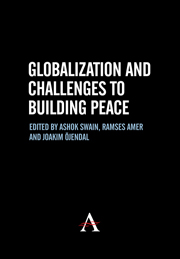Book contents
- Frontmatter
- Contents
- Acknowledgements
- List of Contributors
- 1 Building Peace in the Era of Three Waves
- 2 The Problem of Peace: Understanding the ‘Liberal Peace’
- 3 Pre-emptive Self-defence New Legal Principle or Political Action?
- 4 Beyond Criminal Justice: Promoting the Rule of Law in Post-Conflict Societies
- 5 Peace by Pact: Data on the Implementation of Peace Agreements
- 6 Refugee Repatriation as a Necessary Condition for Peace
- 7 Catapulting Conflicts or Propelling Peace: Diasporas and Civil Wars
- 8 UN Peace Operations as Norm Entrepreneurs: The Challenge of Achieving Communicative Action on Human Rights
- 9 To Practice What They Preach: International Transitional Administrations and the Paradox of Norm Promotion
- 10 Re-examining the Roots of War in West Africa in a Globalizing World
- 11 The African Union (AU) and Its Commitment to Non-Indifference: Can the AU be an Actor for the Promotion of Human Security?
- 12 Hamas Between Sharia Rule and Demo-Islam
- 13 Environmental Scarcity and Intrastate Conflicts: The Case of Nepal
- 14 Narcotics: The New Security Threat for China
- References
- Bibliography
4 - Beyond Criminal Justice: Promoting the Rule of Law in Post-Conflict Societies
Published online by Cambridge University Press: 05 March 2012
- Frontmatter
- Contents
- Acknowledgements
- List of Contributors
- 1 Building Peace in the Era of Three Waves
- 2 The Problem of Peace: Understanding the ‘Liberal Peace’
- 3 Pre-emptive Self-defence New Legal Principle or Political Action?
- 4 Beyond Criminal Justice: Promoting the Rule of Law in Post-Conflict Societies
- 5 Peace by Pact: Data on the Implementation of Peace Agreements
- 6 Refugee Repatriation as a Necessary Condition for Peace
- 7 Catapulting Conflicts or Propelling Peace: Diasporas and Civil Wars
- 8 UN Peace Operations as Norm Entrepreneurs: The Challenge of Achieving Communicative Action on Human Rights
- 9 To Practice What They Preach: International Transitional Administrations and the Paradox of Norm Promotion
- 10 Re-examining the Roots of War in West Africa in a Globalizing World
- 11 The African Union (AU) and Its Commitment to Non-Indifference: Can the AU be an Actor for the Promotion of Human Security?
- 12 Hamas Between Sharia Rule and Demo-Islam
- 13 Environmental Scarcity and Intrastate Conflicts: The Case of Nepal
- 14 Narcotics: The New Security Threat for China
- References
- Bibliography
Summary
Rule of Law in Post-Conflict State-Building
The rule of law has been hailed as a panacea for developing and transition countries. Despite the fact that it has now been almost a decade since Carothers (1998, p. 95) wrote ‘[…] one cannot go through a foreign policy debate without someone proposing the rule of law as the solution to the world's troubles’ there are no signs of a rule of law fatigue.
On the contrary, as some commentators recently stated, rule of law ‘is like apple pie and ice cream’, it is a concept that no one can dislike (Stromseth et al. 2006, p. 58). Typically within development cooperation, donors push for rule of law based on two rationales – rule of law is an essential prerequisite for market economy and it enhances protection of human rights (Messick, 1999; Carothers, 2001).
In relation to post-conflict settings, a third rationale can be added, namely rule of law in the achievement and maintenance of peace and security. This is a rather late contribution to the field of rule of law promotion. Stripped to all essentials the argument goes something like this: human rights violations and high levels of insecurity cause conflict and crisis, and if the rule of law is an essential condition for making human rights a justifiable claim, not merely rights on paper, then it is the key strategy for post-conflict recovery.
- Type
- Chapter
- Information
- Globalization and Challenges to Building Peace , pp. 55 - 72Publisher: Anthem PressPrint publication year: 2007



